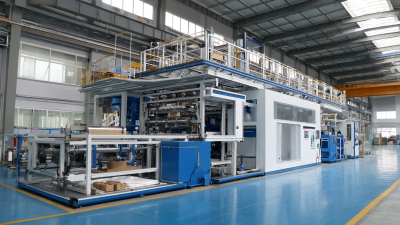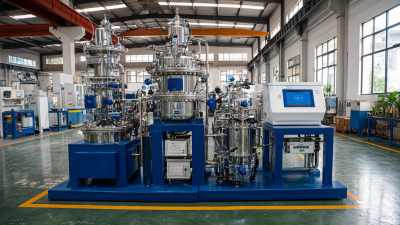Ultimate Guide to Navigating Challenges in the Paper Industry: Best Practices and Solutions
 The paper industry is currently navigating a complex landscape marked by increasing environmental regulations, shifting consumer preferences, and the relentless push for
digitalization. According to a report by Smithers Pira, the global paper market is projected to reach over
$250 billion by 2025, highlighting both the opportunities and challenges that industry players face. While the demand for
sustainable and recyclable paper products is on the rise, manufacturers must also contend with rising
raw material costs and supply chain disruptions exacerbated by recent global crises. This ultimate guide aims to provide actionable insights and best practices for stakeholders in the paper industry, equipping them with the tools
necessary to overcome these challenges and thrive in a competitive market. Through comprehensive strategies and innovative solutions, we can help ensure the longevity and sustainability of this vital sector.
The paper industry is currently navigating a complex landscape marked by increasing environmental regulations, shifting consumer preferences, and the relentless push for
digitalization. According to a report by Smithers Pira, the global paper market is projected to reach over
$250 billion by 2025, highlighting both the opportunities and challenges that industry players face. While the demand for
sustainable and recyclable paper products is on the rise, manufacturers must also contend with rising
raw material costs and supply chain disruptions exacerbated by recent global crises. This ultimate guide aims to provide actionable insights and best practices for stakeholders in the paper industry, equipping them with the tools
necessary to overcome these challenges and thrive in a competitive market. Through comprehensive strategies and innovative solutions, we can help ensure the longevity and sustainability of this vital sector.
Innovative Technologies Transforming the Paper Industry
The paper industry is undergoing a remarkable transformation, driven by innovative technologies that address both environmental concerns and operational efficiency. One of the most significant advancements is the adoption of digitalization and automation. By integrating smart manufacturing systems, companies can monitor production processes in real-time, minimizing waste and optimizing resource utilization. This shift not only reduces costs but also enhances product quality, enabling manufacturers to respond swiftly to market demands.
Moreover, sustainable practices are being revolutionized through the use of environmentally friendly materials and processes. Technologies such as biorefining and waste-to-energy solutions are gaining traction, allowing the industry to turn by-products into valuable resources. For instance, using agricultural residues in pulp production not only decreases reliance on traditional wood sources but also contributes to a circular economy. As these innovations continue to evolve, they pave the way for a more sustainable and resilient paper industry, equipping it to overcome the challenges of today and tomorrow.
Sustainable Practices for Reducing Environmental Impact
The paper industry faces increasing scrutiny over its environmental impact, prompting a shift towards sustainable practices. According to the EPA, paper production accounts for roughly 26% of total industrial energy consumption in the U.S. and is responsible for significant water usage and waste generation. Implementing sustainable practices can significantly reduce these impacts and promote a healthier ecosystem.

One effective strategy is the adoption of recycled paper materials, which can lower energy consumption by up to 60% compared to producing new paper from virgin fibers. Investing in efficient recycling systems not only conserves resources but also mitigates landfill waste. Furthermore, integrating advanced technologies such as digital printing can streamline operations and reduce excess paper usage.
Tips:
- Embrace alternative fibers: Consider using agricultural residues or bamboo, which require less water and land compared to traditional wood fibers.
- Optimize production processes: Regular audits and process improvements can reduce energy consumption and minimize waste production.
- Educate employees: Training staff on sustainable practices fosters a culture of environmental responsibility and enhances overall performance.
Effective Supply Chain Management in Paper Production
Effective supply chain management is crucial for the paper industry, where fluctuations in demand and raw material availability can significantly impact production processes. To navigate these challenges, companies must adopt a proactive approach, integrating advanced technologies for better forecasting and inventory management. Utilizing data analytics tools allows businesses to predict market trends, optimize stock levels, and reduce waste. Furthermore, collaboration with suppliers is essential, enabling a seamless flow of materials while ensuring quality control throughout the supply chain.
Sustainability is another key consideration in managing the paper production supply chain. Implementing eco-friendly practices not only meets consumer demand but also strengthens a company's market position. Companies can work closely with environmentally responsible suppliers and explore alternative raw materials, such as recycled fibers, to minimize their ecological footprint. Additionally, transparency in sourcing and production processes fosters trust with customers and stakeholders, positioning companies as leaders in sustainability in the competitive paper market. By effectively managing their supply chains, paper manufacturers can enhance operational efficiency and respond swiftly to evolving industry landscapes.

Strategies for Improving Operational Efficiency and Cost Control
In the paper industry, navigating challenges while improving operational efficiency and cost control is crucial for staying competitive. One effective strategy is to adopt advanced supply chain management practices. By focusing on supply chain planning and procurement, companies can streamline their processes and reduce waste. Utilizing data analytics can provide insights into market demands and help in optimizing inventory levels, ultimately leading to significant cost savings.
**Tips for Enhancing Operational Efficiency:**
1. Implement robust supply chain strategies that align with your business goals. Regularly review and adjust these strategies to adapt to changing market conditions.
2. Invest in modern technology solutions to automate operations and improve communication across different departments. This can lead to quicker decision-making and enhanced responsiveness to customer needs.
Focusing on value chain analysis also plays a vital role in identifying areas for improvement. By breaking down each segment—from logistics to marketing—companies can pinpoint inefficiencies and devise targeted solutions. Collaborating with experienced operational consultants can uncover best practices tailored to the specific challenges faced in the paper industry, paving the way for sustainable growth and profitability.
Challenges in the Paper Industry: Operational Efficiency and Cost Control
Navigating Regulatory Challenges in the Paper Sector
Navigating regulatory challenges in the paper sector requires a deep understanding of both local and international regulations that govern environmental impact, resource management, and worker safety. With sustainability becoming a cornerstone of industry standards, companies must stay ahead of evolving legal requirements that aim to reduce waste and emissions. Engaging with regulatory bodies early on can help organizations anticipate compliance issues, facilitating smoother operations and minimizing the risk of costly penalties.
Additionally, leveraging technology can greatly assist in meeting regulatory demands. Implementing advanced monitoring systems enables companies to track emissions and waste management processes in real-time, ensuring adherence to environmental laws. Collaborating with industry stakeholders to share best practices and stay informed about regulatory updates is also essential. By fostering a proactive approach to compliance, paper manufacturers can navigate the complex regulatory landscape effectively while supporting sustainable practices that align with consumer expectations and global initiatives.
Ultimate Guide to Navigating Challenges in the Paper Industry: Best Practices and Solutions - Navigating Regulatory Challenges in the Paper Sector
| Dimension | Description | Best Practices | Solutions |
|---|---|---|---|
| Compliance | Understanding and adhering to local and international regulations. | Regular training and updates for staff on compliance standards. | Implementing compliance management software. |
| Sustainability | Efforts to minimize environmental impact. | Adopting sustainable sourcing and production practices. | Investing in eco-friendly technologies. |
| Safety Regulations | Ensuring safety in manufacturing processes and employee well-being. | Conducting regular safety audits and risk assessments. | Developing a comprehensive safety training program. |
| Quality Control | Maintaining high standards in product quality. | Implementing quality management systems (QMS). | Utilizing tools like Six Sigma for continuous improvement. |
| Technological Challenges | Adopting new technologies and innovations in the paper-making process. | Staying informed about industry trends and advancements. | Partnering with tech firms for training and implementation. |
Related Posts
-

Unveiling the Advantages of the Best Pulp Molding Machines for Diverse Product Applications
-

Exploring Alternatives to Best Microfiltration Membrane Technology for Enhanced Water Purification
-

Understanding Industry Production Standards for the Best Micro Filtration System in Use
-

Innovative Solutions for Optimizing Pulp and Paper Production Efficiency
-

Unwavering Quality from Trusted Chinese Manufacturers Featuring the Best Vacuum Filtration Systems
-

5 Industry Applications of the Best Cross Flow Filtration: 7 Compelling Reasons for Implementation